What to grow. Grow along with Byther Farm
Varieties we grow and where to buy them in UK
Below is a list of the plants and varieties that we grew in Monmouthshire in 2015-2020. Wherever possible links are provided to help you find the same varieties to grow in your garden. We catagorise the plants into easy to find groups and included varieties to grow for different uses.
(Disclosure. Some of these are affiliate links. In other words, if you make a purchase we may earn a small commission. View our full disclosure statement)
Fruit and Nut Trees
Fruit trees form the backbone of our food forest, fruit garden and vegetable garden. These fruit bearing trees are the framework around which all the raised beds, vegetables, soft fruit, herbs and flowers grow. Trees provide visual impact, structure and a sense of permanence in a garden and fruit and nut trees offer the additional bonus of providing food too.
I chose which fruit varieties to grow by price of the plants, ease of sourcing the plants and certainly, by the taste of the fruit.
Apple
We eat masses of apples. I use them in cooked in desserts. However I also add them to many main courses to provide additional vitamins and minerals, their sweet and sharp taste and as a bulking agent to make meals go further. We currently grow and Bramley’s Seedling Cooking, Cox’s Orange Pipin, Elstar, Jonagold
Apricot
This variety of apricot is supposed to do well in our climate, as yet we haven’t had any fruit from our tree. Bergeron
Blackthorn
Grown in the hedges all around our site, it provides good shelter for birds and other wildlife and can produce sloes, which are used to flavour sloe gin.
Cherry
Damson and Wild Plum
Elderberry
Sambuscus Nigra H
Hawthorn
The ripe fruits of the hawthorn can be used to make jellies and syrups and also in winemaking.
Hazelnut
Corylus Avellana
Mulberry
Morus Nigra
Peach
Peregrine
Pear
Conference, Doyenne du Comice, Williams
Plum
We grow plums for eating raw, for adding to fruit salads and for using in preserves and in particular in winemaking. They can also be cooked for use in desserts and puddings. Victoria, Opal
Quince
Grown for the perfumed fruits which need to be cooked before eating. They can enhance the flavour of cooked apples. Champion.
The best time to plant a tree was 20 years ago. The second best time is now.
Chinese proverb
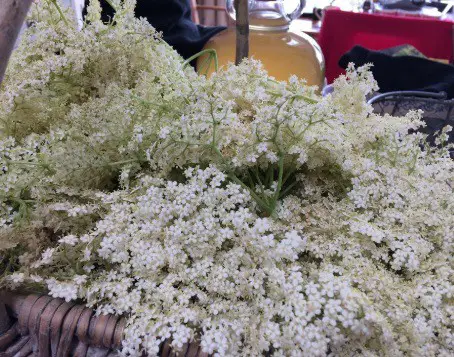
You can buy fruit trees all year round in pots or during the dormant period, late autumn and winter, as bare root trees – this option is often cheaper.
A little care and attention when planting trees will pay off.
Watch the video – How To Plant Fruit Trees
Soft Fruit
Blackcurrant
There are a vast number of varieties to grow. We chose a mix of varieties of blackcurrant to extend the harvesting season. Big Ben, Ben Logan, and a couple of unnamed varieties.
Blueberry
We have several blueberry bushes, the exact varieties are unknown, they were simply label early, mid and late season.
Gooseberry
Gooseberry is not my favourite soft fruit, but Mr J quite likes them, so I grow one variety at the moment. Invicta
Grape
White grape varieties Perlette
Honeyberry
An untidy shrubby bush that bears masses of small black elongated berries. I find honeyberries too tart to eat on their own, but they do add a depth of flavour when mixed with other berries.
Josterberry
A cross between a gooseberry and blackcurrant providing a sweeter berry with a mild gooseberry taste and pinkish purple blush to the skin.
Loganberry
Another cross between raspberry and blackberry. I use the elongated loganberry for jam and wine making.
Pheasant Berry
Lycesteria Formosa. Readily self seeds. An untidy bush that can be cut to the ground each year or left to grow taller. Birds love the berries.
Tayberry
Tayberry is another cross between raspberry and blackberry. I use the elongated berries for jam and wine making.
Thornless Blackberry
Oregon Thornless Byther Farm is surrounded by hedgerows bursting with wild blackberries, but the thornless blackberry is grown in the garden to provide a few more berries and a kinder way for the grandchildren to pick them!
Whitecurrant
The whitecurrants are used for making jelly, in sauces and also for topping yoghurt and cheesecake.
Crops like soft fruits are expensive to buy in store, but easy to grow at home and on the plot.
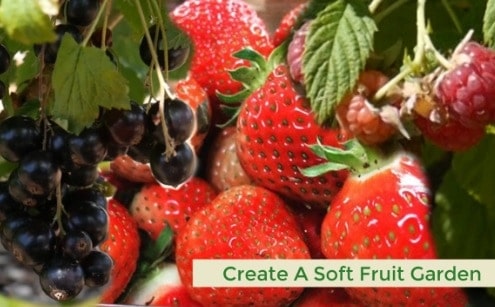
Soft fruits store well in the freezer, although due to the high water content strawberries tend to be very soft when defrosted. I collect and freeze as many soft fruits as possible and then use the winter months to make jams, jellies, ice-cream and wine with them.
Watch the videos – The Raspberry Collection
Perennial Vegetables
Angelica
A short-lived perennial that I have kept growing for longer by removing all the flowering heads. Angelica stems can be crystalised for use in decorating cakes and desserts.
Asparagus
We grow a selection of asparagus to provide a longer cropping season.
Guelph Millenium, Mondeo, Pacific Purple, Pacific 2000
Asturian Tree Cabbage
I like the taste of this Asturian tree cabbage, it has masses of huge paler green leaves.
Babington Leek
Grown for the edible leaves, the bulbous base may also be harvested when it gets large or has produced off-sets. From Incredible Vegetables.
Caucasian Spinach
Hablitzia Tamenoides from Incredible Vegetables. A climbing spinach growing to around 3m high, providing young leaves during the hungry gap of late spring.
Chinese Artichoke
Grown for the small cream colour tubers. These failed for us this year, but we will be trying again next year. I purchased tubers from Incredible Vegetables.
Globe Artichoke
Large architectural plant with silvery leaves, harvest the artichoke flower beds when small or leave to grow for the wild birds to eat.
Nine Star Broccoli
A sprouting broccoli that provides several cuts of flower heads.
Oca
Originating from the Andes, these small knobbly tubers have a slightly lemony flavour. Can be used raw, boiled or roasted.
Salsify
Grown for the roots, salsify has attractive purple flowers borne above straplike leaves. Self-seeds freely. I grew Sandwich Island.
Skirret
Sium sisarum from Incredible Vegetables. Grown for the white roots which are sweeter and more delicate in flavour than carrot.
Taunton Deane Kale
Brassica oleracea var Acephal. Less troubled by pests than many annual brassicas, this kale can grow to 2 metres high and 2 metres wide. Roots readily from cuttings.
Walking Onion
Allium × proliferum. These onions reproduce by forming bulbils on the top of a stem which bends over and deposits the bubils on the soil around it.
Walking Stick Cabbage
The Jersey cabbage grows tall (3-6 metres) with a crown of leaves similar to kale.
In mild areas, some vegetables that are usually grown as annuals may thrive as perennials.

Some of these are short-lived perennials in the UK climate and other veg that are usually grown as annuals, like runner beans, may grow well as perennials.
Watch the videos – The Perennial Veg Collection
Annual Root Vegetables
Root vegetables are the mainstay of our winter vegetables. In the UK, winters are usually mild enough to allow most root veg to be stored in the ground and harvested as needed, saving storage space and time during the busiest harvesting period of late summer and autumn.
Beetroot
We eat a lot of beets, both the leaves and tops can be used. We like them as part of a tray of mixed roasted vegetables and I use beetroots of all colours to make relishes and chutneys. Albina, Boltardy, Burpees Golden, Chioggia, Cylindra
Carrot
Autumn King, Chantenay Red Cored 2, Cosmic Purple, Early Nantes 2, Solar Yellow, Rainbow Mix
Celariac
Giant Prague
Hamburg Parsley
Use the flat leaves as a herb during the summer and in the autumn lift the Hamburg parsley plant and use the roots as a tasty vegetable. We will be growing this again.
Parsnip
Swede, Rutabaga
Lomond
Turnip
Purple Top White Globe, Snowball
Most root crops can be stores in the ground over the winter in the milder parts of the UK.
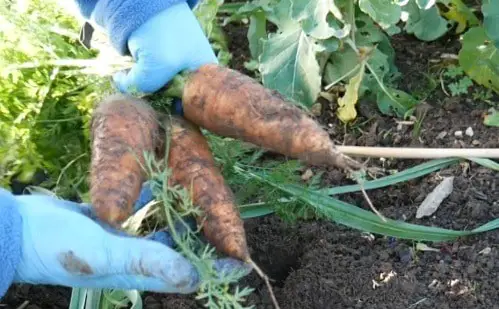
The mainstay of our winter vegetables are stored in the ground and harvested on the day we are going to eat them. My favourite ways of using root vegetables including a tray of roasted mixed root veg or a traditional Welsh soup called Cawl.
Watch the video – How To Make Cawl
Annual Brassicas
- Broccoli Raab Quarantina, Red Admiral F1
- Brussel Sprout Groninger
- Cabbage Filderkraut, Greyhound, Red Acre, Savoy Winter King
- Cauliflower Romanesco, Di Scilia Violetto
- Kale Nero Di Toscana
Kalette A cross between a Brussel sprout and kale, this is the first year that I have grown kalettes. - Purple Sprouting Broccoli Purple Sprouting Early
- Swede, Rutabaga Wilhelmsburger
Plant a few sacrifice cabbages to support the butterfly population and keep your crops covered.
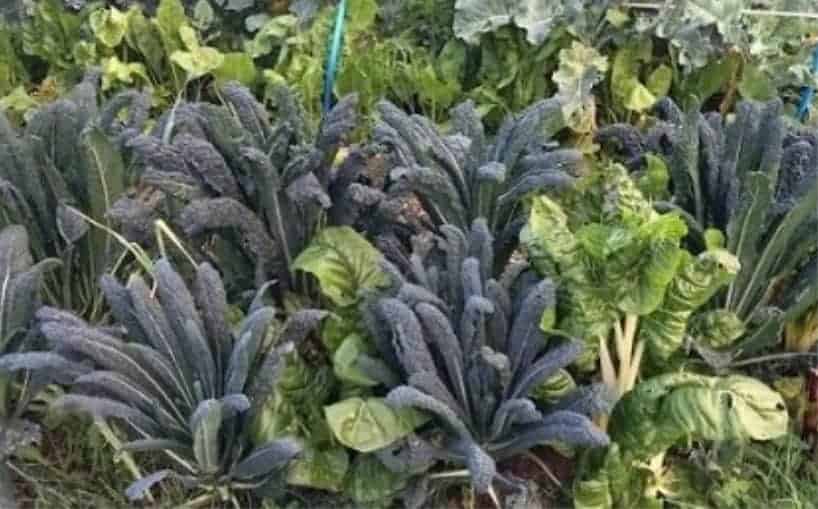
I keep the brassicas covered with netting to help prevent damage by cabbage white and cabbage moth caterpillars. I plant a few spare plants in the flower border to help feed the wildlife population without our food crops being consumed by hungry caterpillars.
Watch the videos – How To Grow Brassicas
Beans Peas and Sweetcorn
- Broadbean Aquadulce Claudia, Bunyards Exhibition, Crimson Flowered (we noticed that these were scented), Express
- Climbing Bean Borlotti
French Bean (dwarf, bush) Polka
Runner Bean White Lady, Greek Gigantes - Mangetout, Snowpeas Oregon Sugarpod, Purple Podded Shiraz (we didn’t like these much, but they are worth a try)
- Peas Progress no 9, Kelvedon Wonder
Sweetcorn Special Swiss, True Gold
I prefer to grow vegetables for quality of flavor rather than quantity of harvest.
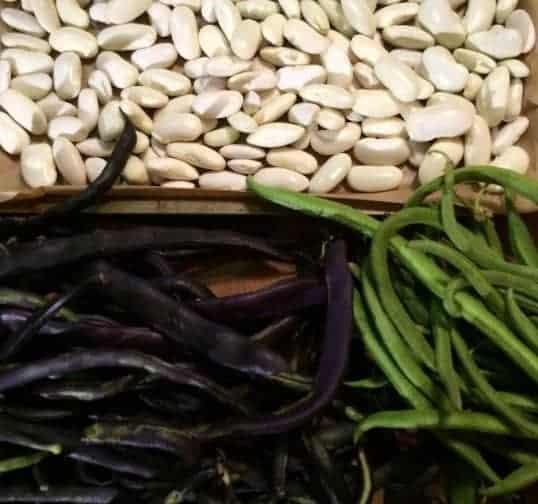
I grow the runner beans as perennials, but sow a few extra seeds each year to replace any plants that haven’t made it through the winter.
Watch the videos – How To Grow Beans
Onions Garlic and Alliums
Autumn Planted Onion Sets Senshyu, Shakespere, Radar
I bought all my onion sets here.
Garlic Carcassonne, Early Purple, Germidour, Messidrome, Provence, Solent Wight
All the garlic sets were purchased on Amazon, for 2020 I have saved cloves to plant.
When onions are almost ready to harvest, I cut some of the leaves and chop them to freeze. They are perfect to add to omelette or stir-fry meals.

I use a lot of onion flavours in the kitchen so having a selection of tastes is important to me.
Watch the videos –How To Make A String Of Onions
Potatoes and Tubers
- Potatoes I grew a large selection of potato varieties including
- Desiree, Marabel, Maris Piper, Picasso, Red Duke of York
- Oca Unknown varieties, but they are white, yellow, pink and red varieties. Available at Real Seeds.
- Yacon Purchased from Real Seeds for 2019, I will be saving the growing tips from the crowns to replant for next year.
Our first year growing yacon, we like the taste of them grated into salads and I love their little yellow flowers.

I grew masses of potatoes in 2019, for next year I will grow fewer and use the space for other vegetables.
Watch the videos – How To Grow Potatoes
Salads and Leafy Vegetables
- Beet Leaves and Chard Rainbow Chard Bright Lights, Rhubarb Chard, White Silver 2 Chard
- Celery Utah
- Cress Curled cress
- Kale Red Russian
- Leaves Mizuna, Wild RocketSalad Rocket
- Lettuce Gourmet Mixed, Little Gem, Lollo Rosso, Red Oak Leaf, Winter Density
- Mustard Oriental Ruby Streaks
- Pea Shoots Grown for cutting when a few inches high Kelvedon Wonder, Oregon Sugar Pod
- Radish French Breakfast
- Cucumber Spacemaster 80
Growing ‘cut and come again’ lettuces means I can start harvesting earlier and continue for around 3 – 4 harvests.
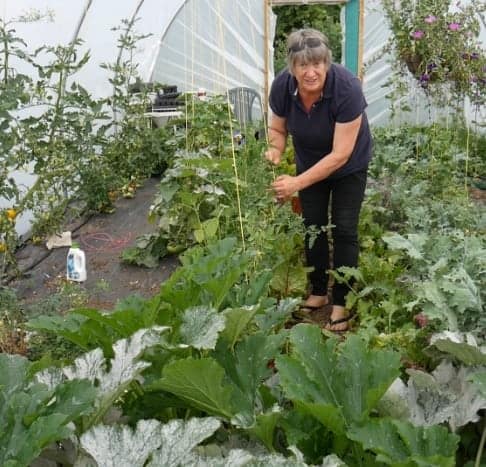
I grew salads in the polytunnel and in the garden to extend the harvesting season. We will be eating freshly harvested lettuce and mustard leaves on Christmas Day!
Watch the videos – Winter Salads
Tomatoes and Aubergine – Egg Plants
Aubergine, Egg Plant Little Fingers
Tomatoes Cerise, Cherry (no further info on the seed packet), Golden Sunrise, San Marzano, Tigerella
In the polytunnel the sweetest tomato was the Golden Sunrise, the most prolific was Cerise.

I didn’t plan to grow any tomatoes this year, but a generous gift meant I could try out several varieties. Aubergines were also a first for our garden and I really enjoyed growing and eating them.
Watch the video – Seasonal Eating
Pumpkins and Squashes
- Autumn Squash Butternut Waltham, Jumbo Pink Banana, Sibley, Spaghetti,
Uchiki Kuri - Summer Squash Patty Pan White, Patty Pan Yellow, Courgette, Zucchini, Black Beauty, Courgette, Zucchini Cocozelle di Napolini, Golden Zucchini.
- Cucumber Spacemaster 80
Squash provides a welcome filling food in the depth of winter. It can be used for savory and sweet dishes.

Once harvested, I cure the winter squash by allowing the skins to dry and harden in an airy room temperature place, like the kitchen table, once cured they can be stored in a cool, but not cold room for long periods.
Watch the videos – Easy Way To Grow More Squash On The Same Plant
Herbs
When choosing which herb varieties to grow, I picked some old favorites, some that are new to me including some herbs to use as a living mulch or ground cover.
Annual
Basil Genovese, Dill, Curled Parsley (which grows as a short-lived perennial in our garden), Flat leaf parsley, Feverfew
Perennial
Lovage, Sweet Bay, Rosemary, Thyme, Marjoram, Chives, Garlic Chives, Sweet Cicely, Bronze Fennel, French Tarragon, Winter Savoury.
Herbs can enhance the flavors of other foods and spice up a meal.

I have a raised herb bed close to the kitchen for the herbs that I use most often and also have plenty of herbs in the food forest and vegetable gardens. Some herbs I grow in larger quantities for inclusion in our CSA Veg Boxes.
Watch the video – 5 Easy Perennial Herbs
Edibles Flowers
A selection of the varieties to grow to add edible flowers to your meals. Care is needed to be sure that your choices are safe to eat, therefore please do your own research.
Flowers
Blue Borage, Calendula, Chives, Courgette, Zuchini, Lavender, Nasturtium, Pansy, White Borage
Flower Hips and Berries
Blackthorn, Elderflower, Hawthorn, Roses
Flower Stems
Angelica, Soloman’s Seal (young growing tips can be eaten like asparagus)
Some traditionally ornamental plants have flowers, stems or fruits that are edible. They need careful research so that you don’t poison yourself.

I was surprised by how many ornamental plants also have edible parts. Please be cautious and do careful research before you start!
Watch the videos – How To Grow Beans
For Wine Jam and Jelly
Fruit
Blackberry, Damson, Elderberry, Plum, Raspberry, Rose Hips, Strawberry
Vegetables
Beetroot, Rhubarb, Parsnip, Yacon
Simple country wines, jams and jellies are easy to make using very few ingredients.

For Bees
A selection of some of our favourite varieties to grow to support our bees throughout the year.
Flowers
Chives, Clover, Cosmos, Borage, Ivy, Mahonia
Fruit
All the fruit produce flowers, but we notice some are visited more than others, especially the early blossoms of damson, wild plum and elderberry and then the single open blooms of raspberries, blackberries and their various crosses.
Vegetables
Angelica, Carrots, Runner bean White Lady, Greek Gigantes bean,
Pumpkin, squash and courgette or zuchini, Skirret, Sweet Cicely
Encouraging pollinators into the garden helps to increase yields of many fruits and vegetables. We grow some varieties purely to support the bee population.
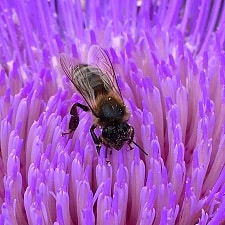
I try to ensure that there are some flowers available to the bees all year round. Watch the videos – Harvesting Honey
Seed companies we use regularly
Tamar Organics
- Baby pepper inside pepper | Strange vegetable - September 16, 2025
- Biennials to sow in June and July - September 12, 2025
- Protected: Urban back garden - August 28, 2025
